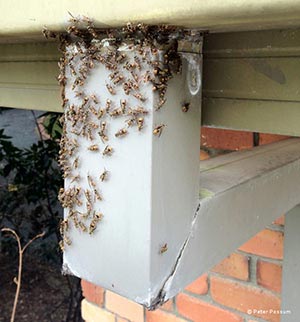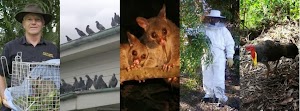1. ANIMAL DESCRIPTION
Common name: European Wasp
Scientific name: Vespula germanica
SIZE
Between 12mm – 15mm. The queen is larger and grows up to 20mm.
FEATURES
The European wasp looks similar in size and shape to that of a common bee. It has a bright yellow body with black bands around its abdomen with triangle shaped markings down the centre. It has two long antennae on the front of its head and relatively large transparent wings. Its legs are mostly yellow coloured and it has a large wide body, when compared to the native paper wasps.
The markings of most of the Australian native wasps are very unlike the black and yellow patterned markings of the European wasp. However there is at least one species, found in Brisbane nesting in the wall of a brick home in 2010, that is very similar. It was identified by the Brisbane museum from photographs taken by Peter Possum as Ropalidia socialistica. It is only 7.5-8.5 mm in body length but it has very distinct yellow and black/brown bands on its body and head. It lives in large colonies in cavities. With the bright yellow and contrasting dark stripes, it looks like a smaller version of the European wasp but its central body parts are much thinner.
PEST STATUS
It is an introduced pest from Europe. It offers no economic benefits and has spread through the southern parts of Australia (outside the tropical areas). It is considered a pest due to two main points;
1) It’s ability to sting repeatedly, without dying (unlike the honey bee)
And
2) The ecological damage to the environment as the wasps prey upon native insects, and especially spiders and caterpillars.

Wasps Making Nest
2. ECOLOGY AND BEHAVIOUR
The European wasp was recognized for the first time in Australia in 1959. The first place they were identified was Tasmania. Since then they have spread through the south eastern corner of Australia spreading from Melbourne in 1977. European wasp nests have been located as far north as the south east corner of Queensland.
They build their nests from paper which they create by chewing timber fibres and plant materials and mix this with their own saliva. The nest is based upon 6 sided hexagonal shaped egg cells which look similar to a bee’s honeycomb. However, unlike bees, the outside of the nest structure is enclosed in a paper-like grey material and there are only a few small entrance holes. The nests can typically be constructed up to a size of 200mm diameter depending on the health of the colony and the time of the year.
The nest is usually hidden away in a tree hollow or building cavity, somewhere protected from wind and rain. However in New Zealand there have been some gigantic nests recorded, many metres in size; in 2012 the Garrards pest review magazine had an article which included photographs of a nest that was 1.8 metres by 0.9 metres in diameter. It was found by Chris & Cecily Ault on the bank of a tidal creek called Brighams Creek, hidden amongst shrubs and ferns. The same article reports a world record wasps nest also found in New Zealand in 1963, that was 3.6 metres long and 1.75 metres in diameter!
It has been noted by scientists who study them that they have no significant natural predators in Australia and the weather conditions are perfect for their reproduction. Adding to the wasp’s adaptation to Australia is their preference to live near human beings who provide them with abundant food sources. Exposed pet food and food scraps and unsealed compost bins are the perfect food sources that attract wasps to people’s homes.
3. BREEDING
Their wasp nest is usually located in a hidden underground bunker. If they choose to make a human structure the location of its nest it usually will be in a roof or wall cavity. Their nest is usually only accessed by a small hole. This allows the wasp to maintain security of the nests entry from any possible attackers.
They form large colonies that can number into the thousands as they are a social insect with a well organised colony structure.
The wasps are at their peak numbers and activity in the summer time. The colony wanes during the autumn period and mostly dies off in winter.
The colony’s queen then hibernates during the winter months and then arises during the start of the spring season ready to establish a new colony. As with all wasp colonies the first born generation of the summer are sterile workers whose sole purpose is to raise the next generation of wasps who will become the breeding generation to commence new wasp colonies.
4. HOME OWNER PROBLEMS
They are not a destructive insect to people’s homes. Their nest is not invasive and does not cause significant noticeable damage to the structure or walls.
However they can cause problems for home owners due to their ability to repeatedly sting without dying. It has also been noted that wasps will not hesitate to become aggressive and over protective of their nest and attack humans that come near to their nest.
Symptoms of a sting
The European wasp can sting repeatedly. The attacking wasp emits a chemical pheromone scent on to the person that has threatened the nest, which then alerts other wasps to attack the person.
Their sting is associated with a burning pain around a raised red lump on the skin where the sting was perpetrated. Some people can suffer an allergic reaction to the wasp sting. This reaction can be worse if the stinging is experienced near the air ways of the person.
The venom does contain certain toxins that cause allergic reactions in around 1 out of every 10 people. If a person who is stung suffers a severe reaction to the toxin then anaphylaxis may occur which could lead to life threatening symptoms which may include;
– Swelling of the air way around the mouth, lips, tongue and throat
– Strained breathing
– Noisy and laboured breathing
– Difficulty swallowing
– Tightness in the upper chest area
– Increased heart rate and racing of the pulse
– Weakness and dizziness
– Young children or the elderly may become unconscious or exhibit signs of lethargy and floppy limbs
Wasp Control
The most effective means to control a wasp problem is to engage an experienced pest controller from Peter the Possum & Bird Man to locate their nest and destroy it. If you attempt to destroy the nest yourself the wasps will defend their nest aggressively. So a bee keeper’s suit is essential.
The qualified pest controller will take necessary precautions for themselves and your family.
It will assist our pest controller if you locate the wasp nest before you call but do not disturb the nest or attempt to kill a few wasps.
NOTE; IF A FEW WASPS FLY NEAR YOU OR SETTLE ON YOU, DO NOT WAVE YOUR ARMS ABOUT OR SWAT THEM. Any sudden movements will be considered aggressive and the whole hive will be called out to attack the danger. It may not be easy but keep calm and move slowly away.
IF ONE WASP STINGS YOU: get out of the area FAST as others will come and should you return even a few hours later, there is a real risk they will remember your unique smell and return to attack again. However a different person, moving slowly near the nest will often not be attacked
5. SUMMARY – HOW CAN PETER THE POSSUM MAN HELP YOU?
Call Peter the Possum Man and ask for the friendly serviceman who is the Brisbane wasp removal specialist. Our highly trained wasp pest controllers and wasp removalists will attend to your unwanted Brisbane wasps promptly and efficiently. We have over 25 years of experience and we know all the best techniques to remove unwanted wasps today.
The benefit is that you do not risk the potentially relentless stinging of the wasps during the wasp removal.







